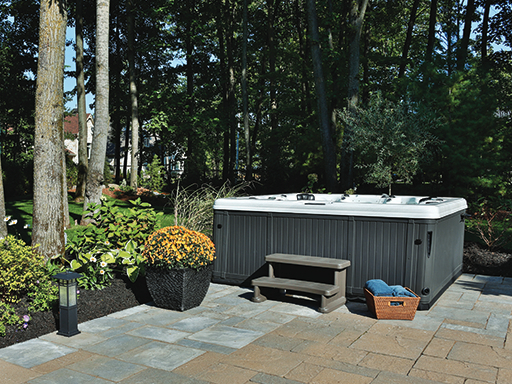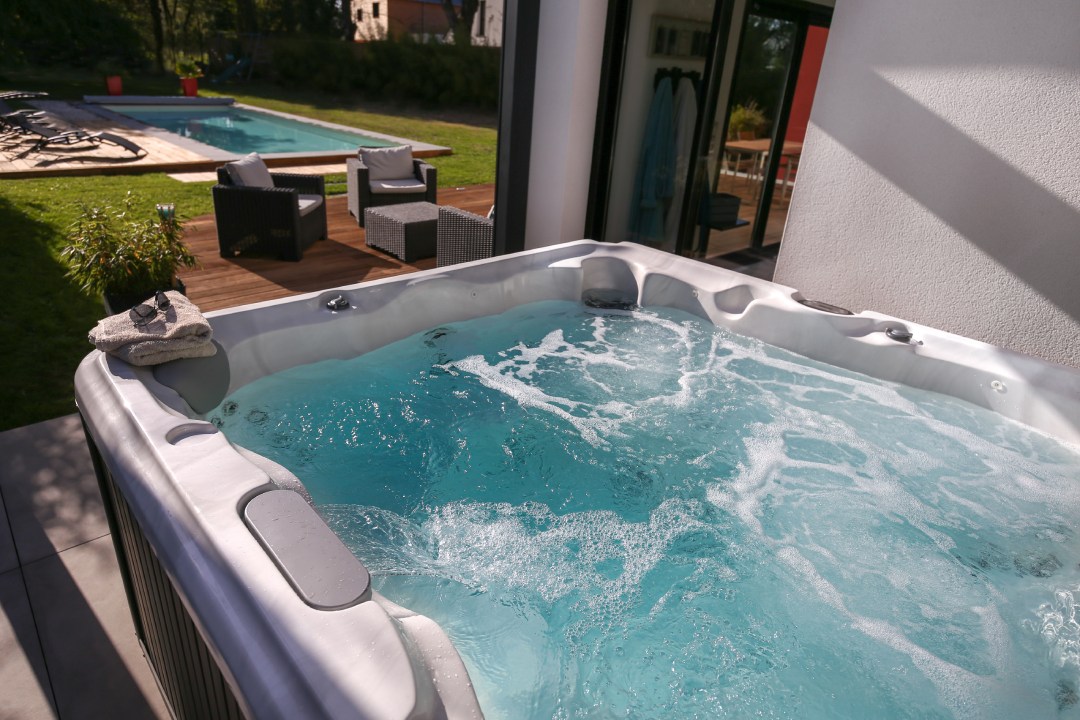Treating yourself to a spa is a wonderful way to enjoy moments of relaxation at home, alone, as a couple, with family, or with friends. Before taking the plunge, it’s essential to clearly define your needs in order to choose the model that best suits your lifestyle, space, and budget.
Discover our best tips for choosing the right hot tub for you.
Features to consider when choosing a hot tub
Size: how many seats and what dimensions?
The first step in choosing a spa is to think about its main use. Would you like to share your relaxation sessions with your partner? A 2 or 3-person spa is the obvious choice, but opting for a larger size will allow you to fully enjoy several types of massage, target different areas, and not feel cramped. Are you imagining convivial moments with family or friends? Opt for a 4 to 6-person hot tub. Do you enjoy entertaining or want a generous wellness space? Some models offer 7 seats or more.
Always check the exact dimensions of the spa: length, width, depth. This will prevent any unpleasant surprises during installation, especially if you plan to install it in a confined space.
Comfort and style: jets, pumps, and design
Comfort is probably the element that will make all the difference once the spa is installed. Several factors should be compared:
- The jets: their locations play a crucial role in determining which areas will be massaged. If you tend to experience lower back pain, make sure that the hydromassage jets are positioned in those areas. Some spas offer targeted massages for the neck, lower back, legs, or feet. The number of jets will also allow you to enjoy a variety of massages, and adjustable jets will allow you to control the strength.
- Pumps: These have two functions in a hot tub. They circulate the water to filter and heat it, and they also provide the power to operate the jets. Some spas are equipped with two-speed pumps; the low speed is used for filtration and the high speed to power the jets. Alternatively, a circulation pump can be added to filter and heat the water, while more powerful pumps are used exclusively for the jets. These are the two configurations that save energy, as high power is only used when the spa is in use. Depending on the number of jets, a spa may need one or more pumps of the right power to operate all the jets.
- The ergonomics of the seats: molded seats, lounge seat, headrests… Each model offers a different experience. Try to imagine yourself using it: relaxing while lying down, sitting and chatting… Ideally, test the seats if possible! This will give you an idea of the comfort and water level.
- Atmosphere and style: multicolored LED lighting, waterfalls, Bluetooth speakers… The spa can become a true sensory wellness space.
- Customization: color of the tub, exterior cladding, etc. Your hot tub should also blend harmoniously into your interior or garden.

Installing your spa
Installing your outdoor hot tub can be a tedious task, but it is essential to ensure long-term safety and comfort. Before getting started, there are some technical points that must be checked. The strength of the ground is essential: a spa filled with water and occupied can easily exceed one ton, which requires a flat, stable, and resistant surface. The electrical connection is another important aspect. Most spa models require a dedicated 240 V power supply with a protective circuit breaker installed nearby to ensure optimal safety. However, there are more compact, “plug-and-play” models that can be connected to a standard household outlet. Having the installation carried out by a certified electrician is mandatory in order to enjoy your spa.
Aqua Master will help you choose your spa and take care of delivery and installation. Discover our home spa installation service.
Insulation and heating: coping with the cold
If you want to use your spa all year round, it is essential to ensure that it is suitable for winter use, especially in regions with harsh cold. All our spas are selected for use in every season!
A well-insulated spa will retain heat and be more economical. Thermal insulation of the spa requires high-quality insulating materials in the spa structure, on the shell, and even at the base. Finally, an effective cover is necessary to reduce heat loss when not in use.
You can also check the heating power of your spa. Depending on its size and your location, a power rating of 4 kW or even 5.5 kW is recommended to heat it more quickly and maintain its temperature when you are using it, especially in winter. “Plug-and-play” hot tubs, which are often smaller, have a 1 kW heater, which is sufficient since they are very well insulated. Most of these spas can be converted to 240V if you want higher performance.
The budget for a spa: purchase price and running costs
The price of a hot tub will depend on the above criteria, but you can expect to pay several thousand dollars for the purchase and installation. In addition to the purchase price, it is important to anticipate the budget required for your spa’s electricity consumption. The number of jets and pumps will affect its electricity consumption, but so will the spa’s insulation. With low heat loss, it will heat up again more quickly, reducing your energy bill.
By choosing a high-performance, well-insulated spa model, you can optimize its durability and control your long-term expenses.
Our spa suppliers configure their spas with energy efficiency in mind, so that you don’t have to worry about it and can simply enjoy your spa as much as you want without thinking about it, because your relaxation is what matters most!

Making the right choice for your spa
Selecting the right hot tub is an important decision, as it will provide you with many years of relaxation. So, before buying a spa, keep these essential criteria in mind:
- Size: number of seats and dimensions suited to your space.
- Comfort: massage quality and number of seats
- Installation: plug and play or connection by a certified electrician
- Insulation: to reduce heat loss
- The budget: purchase price and operating costs




Leave us your comment